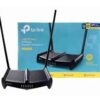TP-Link TL-WR841HP 300Mbps High Power Wireless N Router Proftech
TP-Link TL-WR841HP 300Mbps High Power Wireless N Router delivers extended wireless coverage through amplified transmission power, reaching areas that standard routers struggle to serve effectively. This single-band router operates on the 2.4GHz frequency with enhanced signal strength, providing reliable internet access across larger homes, multi-story buildings, and challenging environments with thick walls or significant obstacles.
Unlike conventional routers limited by standard power output regulations, this high-power design maximizes allowable transmission strength to penetrate walls, floors, and other barriers more effectively. The router supports wireless speeds up to 300 Mbps while extending coverage range by approximately 30-50% compared to typical wireless N routers, making it particularly valuable for users prioritizing coverage area over cutting-edge speed specifications.
High Power Transmission and Extended Range Capabilities
Enhanced Signal Strength Technology
The TP-Link TL-WR841HP 300Mbps High Power Wireless N Router optimizes wireless coverage through amplified transmission:
- Increased transmission power: Enhanced RF output within regulatory limits for maximum legal signal strength
- Multi-antenna configuration: Multiple external antennas focus and direct wireless signals efficiently
- Advanced antenna design: Optimized antenna placement and gain characteristics improve signal distribution
- Beamforming-like focusing: Directional signal enhancement toward connected devices
Coverage Area and Penetration Performance
Real-world testing demonstrates significant range improvements over standard routers:
- Large home coverage: Effective wireless service across homes up to 2,500 square feet
- Multi-story performance: Reliable signal transmission through floors and between building levels
- Wall penetration: Enhanced signal strength maintains connectivity through concrete, brick, and multiple interior walls
- Outdoor extension: Extended coverage to covered patios, garages, and nearby outdoor areas
Wireless N Technology and Performance Specifications
300 Mbps Speed Distribution and Capabilities
Single-band wireless performance provides reliable connectivity for typical internet activities:
- 2.4GHz operation: 300 Mbps maximum theoretical speed using 802.11n wireless standard
- MIMO technology: 2×2 antenna configuration improves signal quality and throughput
- Channel bonding: 40 MHz channel width support doubles bandwidth compared to 20 MHz channels
- Backward compatibility: Full support for 802.11g and 802.11b legacy devices
Real-World Throughput Expectations
Practical performance varies based on distance, obstacles, and interference conditions:
- Close-range performance: 100-150 Mbps typical speeds within 50 feet of router
- Extended range operation: 40-80 Mbps at coverage boundaries where standard routers fail completely
- Multi-device handling: Stable performance with 10-15 simultaneously connected devices
- Interference resistance: Enhanced signal strength helps overcome neighboring network interference
Network Features and Connectivity Options
Physical Port Configuration
Wired connectivity supports various networking requirements:
- Fast Ethernet WAN port: 100 Mbps connection to cable, DSL, or fiber internet services
- Four Fast Ethernet LAN ports: Wired connections for gaming consoles, desktop computers, and network devices
- Auto-negotiation: Automatic speed and duplex detection for optimal wired performance
- Link status indicators: LED lights confirm active connections and data activity
Advanced Router Functionality
Professional networking features enhance home and small office operations:
- Quality of Service (QoS): Bandwidth allocation and traffic prioritization for different applications
- Guest network capability: Separate wireless network for visitors with restricted access
- Access control: MAC address filtering and time-based internet restrictions
- Port forwarding: Application-specific traffic routing for servers and gaming
Security Features and Network Protection
Wireless Security Protocols
Comprehensive protection against unauthorized network access:
- WPA2 encryption: Industry-standard wireless security with AES encryption
- WPA3 support: Latest wireless security protocol for enhanced protection (where available)
- Network isolation: Guest network separation from main network resources
- Access point isolation: Prevents wireless devices from communicating with each other
Firewall and Network Defense
Built-in security features protect against internet-based threats:
- SPI firewall: Stateful packet inspection prevents unauthorized incoming connections
- DoS attack protection: Defense against denial-of-service and common network attacks
- VPN pass-through: Support for PPTP, L2TP, and IPSec VPN connections
- Content filtering: URL-based website blocking and access restrictions
Setup Process and User Interface
Initial Installation and Configuration
The TP-Link TL-WR841HP 300Mbps High Power Wireless N Router simplifies network setup:
- Web-based configuration: Browser interface accessible from any connected device
- Quick setup wizard: Step-by-step guidance through initial internet and wireless configuration
- WPS connectivity: One-button wireless setup for compatible devices
- Mobile app support: TP-Link Tether app provides smartphone-based management
Management Interface and Monitoring
User-friendly controls provide comprehensive network oversight:
- Real-time status monitoring: Connected device tracking and bandwidth utilization
- Wireless signal analysis: Channel selection and interference assessment tools
- Parental controls: Internet scheduling and content filtering for children’s devices
- Firmware updates: Automatic and manual update options for security and performance
Ideal Applications and Use Cases
Large Home and Multi-Story Environments
The router’s extended range capabilities address specific residential challenges:
- Ranch-style homes: Single-floor homes with significant square footage requiring comprehensive coverage
- Multi-story houses: Reliable connectivity between floors and distant bedrooms
- Challenging layouts: Homes with thick walls, concrete construction, or complex floor plans
- Outdoor entertainment: Extended coverage to decks, patios, and yard areas
Small Business and Office Applications
Professional environments benefit from reliable extended coverage:
- Small retail locations: Customer and point-of-sale connectivity throughout store areas
- Office suites: Reliable internet access across multiple rooms and workspaces
- Warehouse connectivity: Extended range for inventory systems and mobile devices
- Conference facilities: Meeting room connectivity without additional access points
Antenna Configuration and Positioning
External Antenna Design
Multiple external antennas optimize signal transmission and reception:
- Dual or triple antenna configuration: Multiple antennas provide signal diversity and improved coverage
- Adjustable positioning: Manual antenna orientation for optimal signal direction
- High-gain characteristics: Enhanced antenna gain amplifies signal strength beyond standard designs
- MIMO implementation: Multiple antennas enable spatial diversity and improved throughput
Optimal Router Placement Strategies
Proper positioning maximizes the high-power transmission advantages:
- Central location: Positioning near the geographic center of coverage area
- Elevated installation: Higher placement improves signal distribution and range
- Obstacle avoidance: Clear line-of-sight to primary usage areas enhances performance
- Interference mitigation: Distance from microwaves, cordless phones, and other 2.4GHz devices
Performance Analysis and Speed Expectations
Coverage vs. Speed Trade-offs
Understanding the relationship between extended range and throughput:
- Signal strength priority: Design optimizes coverage range over maximum speed
- Distance-based performance: Speed decreases with distance but maintains usable connectivity
- Penetration capabilities: Signals reach areas where other routers provide no service
- Consistent connectivity: Stable connections across extended coverage areas
Bandwidth Management and Optimization
Effective utilization strategies for 300 Mbps capacity:
- Application prioritization: QoS settings ensure critical applications receive adequate bandwidth
- Device management: Monitor and control bandwidth usage by individual devices
- Channel optimization: Manual channel selection avoids congested frequencies
- Usage scheduling: Time-based controls manage network load during peak periods
Limitations and Technology Considerations
Single-Band Operation Constraints
The TP-Link TL-WR841HP 300Mbps High Power Wireless N Router operates within specific technical boundaries:
- 2.4GHz limitations: Subject to interference from microwaves, baby monitors, and neighboring networks
- 300 Mbps shared bandwidth: Total wireless capacity distributed among all connected devices
- Fast Ethernet ports: 100 Mbps wired connections may limit very high-speed internet services
- Wireless N technology: Older standard lacks advanced features found in AC or AX routers
When to Consider Alternative Solutions
Different networking solutions may provide superior performance for specific requirements:
- Dual-band needs: AC routers offer 5GHz band for reduced interference and higher speeds
- Gigabit internet: Modern routers with gigabit ports and faster wireless standards
- Mesh networking: Whole-home mesh systems for very large or complex layouts
- Wi-Fi 6 technology: 802.11ax routers provide advanced efficiency and speed features
Energy Efficiency and Environmental Impact
Power Consumption and Operating Costs
High-power operation involves specific energy considerations:
- Increased power usage: Enhanced transmission power requires additional electrical consumption
- 24/7 operation: Continuous operation contributes to household electricity usage
- Heat generation: Higher power output produces more heat requiring adequate ventilation
- Energy efficiency features: Power-saving modes during low usage periods
Environmental Operating Specifications
- Operating temperature: Suitable for typical home and office environmental conditions
- Humidity tolerance: Designed for standard indoor humidity levels
- Ventilation requirements: Adequate airflow prevents overheating during continuous operation
- Physical durability: Robust construction suitable for permanent installation environments
Long-Term Value and Technology Evolution
Investment Perspective and Upgrade Planning
Evaluating the router’s role within evolving home networking requirements:
- Coverage priority value: Continues providing benefit where range matters more than speed
- Technology lifecycle: Wireless N remains functional despite newer standards availability
- Internet speed matching: Adequate for internet plans up to 200-250 Mbps
- Replacement timeline: 3-5 year useful life before newer technologies provide significant advantages
Future-Proofing Considerations
Understanding technology trends and their impact on router relevance:
- Internet speed growth: Broadband speeds may eventually exceed router capabilities
- Smart home expansion: IoT device growth may require advanced traffic management
- Security updates: Ongoing firmware support maintains protection against evolving threats
- Standards evolution: Wi-Fi 6 and future standards offer improved efficiency and features
Troubleshooting and Maintenance
Common Issues and Resolution Strategies
Typical problems and their solutions help maintain optimal performance:
- Coverage gaps: Antenna repositioning and router placement optimization
- Speed variations: Channel selection and interference source identification
- Connection stability: Firmware updates and power management settings
- Overheating concerns: Ventilation improvement and environmental monitoring
Support Resources and Documentation
TP-Link provides comprehensive support infrastructure:
- Online knowledge base: Setup guides and troubleshooting documentation
- Community forums: User-generated solutions and configuration tips
- Technical support: Professional assistance for complex installation issues
- Warranty coverage: Standard manufacturer protection against hardware defects




Reviews
There are no reviews yet.